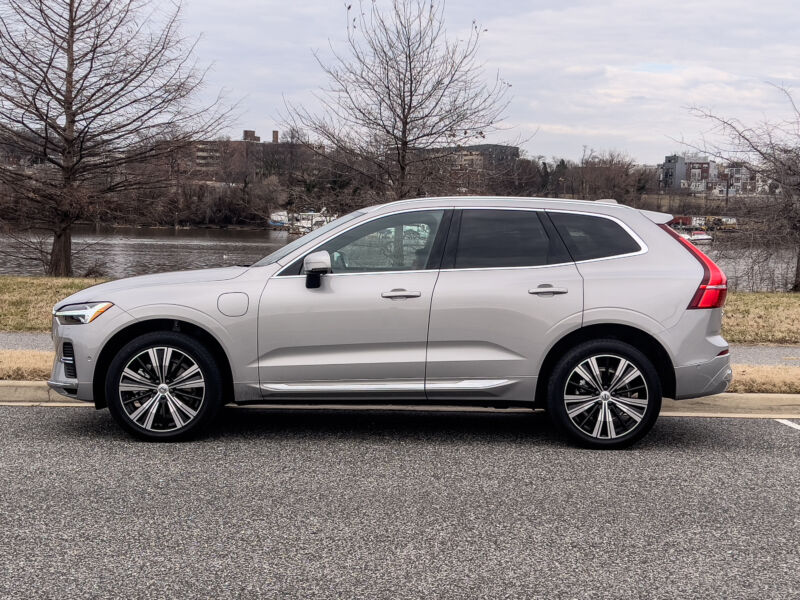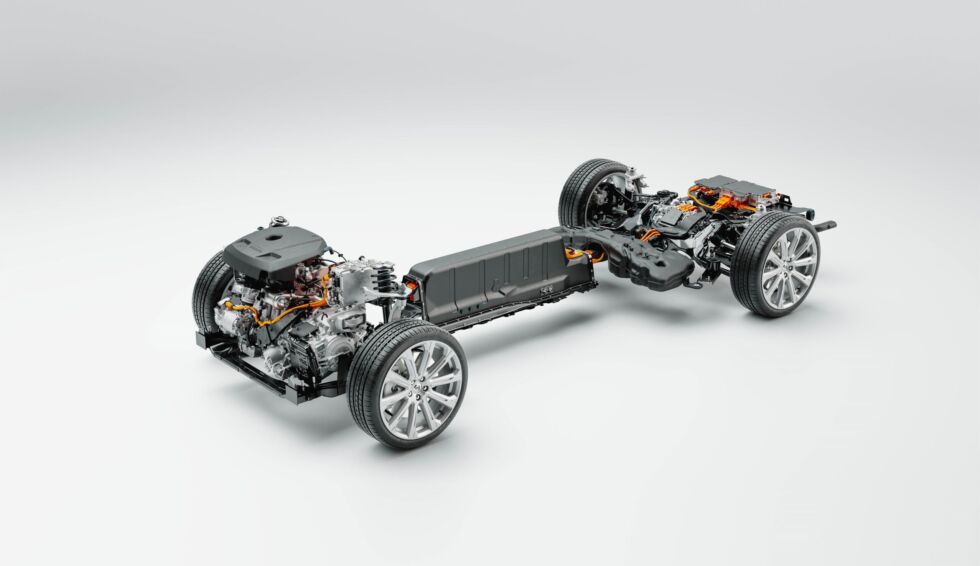
Back in 2018 we tested the Volvo XC60 plug-in hybrid, Sweden's midsize electrified crossover. A handsome thing, it has mostly supplanted the trusty Volvo station wagon, as car buyers prefer the loftier driving position but want to keep a generous cargo capacity and a handy rear hatch. Last year, Volvo gave the crossover its midlife refresh, adding a hefty bump in battery capacity—and therefore electric driving range—in the process.
At the time, I wrote that the XC60 made a compelling case for itself, but is that still true five years later?
Visually, the Volvo's facelift appears extremely subtle. The XC60 was already a handsome-looking machine—I find most of the current Volvos to be easy on the eyes—but I would struggle to tell you what has changed when comparing photos of the older and newer cars. It's perhaps a case of "don't fix it if it's not broken."
Don't think Volvo forgot about the car, though. While the exterior styling is relatively unchanged, that isn't quite as true if you delve beneath the skin. The most significant change is the upgraded hybrid powertrain, which uses a new, longer-range battery. Gross capacity has increased from 11.6 kWh to 18.8 kWh, with an increase in useable capacity from 10.4 kWh to 14.9 kWh.

That equates to an increase in the electric-only range from 17 miles for the older version to 35 miles, according to the Environmental Protection Agency. (WLTP electric range is 77 km, which tells you a lot about the different testing regimes.)
There's also a new electric motor driving the rear wheels. This now boasts 143 hp (107 kW), up from 87 hp (65 kW). That works together with the four-cylinder, 312 hp (233 kW) gasoline engine that drives the front wheels, to give a combined power output of 455 hp (339 kW).
Volvo says that the more powerful electric motor makes for better all-wheel drive performance at low speed and when towing. We didn't have the opportunity to test that, but I did make extensive use of the new one-pedal driving mode. Annoyingly this is engaged via a submenu in the infotainment system—Volvo HMI designers, if you're reading this, it should be a button or perhaps an extra stop on the transmission shifter. Similarly, the switch that one used to use to switch between hybrid modes—pure EV, hybrid, and engine-always-on—has now also been deleted and those controls relegated to a submenu in the infotainment system, which is more than a little annoying.
This mode increases the regenerative braking from the electric motor so that there's a very intuitive relationship between your foot on the throttle pedal and the car accelerating or slowing. And it's very well-judged for driving in traffic—on longer highway drives, some may find it preferable to disable one-pedal driving and lift and coast instead.
-
Although the plug-in hybrid Volvo XC60 now has a bigger battery and more range, it has lost eligibility for the IRS tax credit.Jonathan Gitlin
-
A 21st-century station wagon.Jonathan Gitlin
-
Electrons go here. With a full gas tank and a full battery the XC60 Recharge should have a range of about 520 miles (837 km).Jonathan Gitlin
One drawback to the larger battery on the hybrid system is that it takes longer to charge. Expect to wait about five hours to fully charge the pack using a level 2 (240 V, 16 A) charger, or longer if you can only find a 120 V outlet. That effectively kills off the idea of using public chargers unless you're going to be stationary for a long time—just plugging in for an hour will only add five to six miles (8-10 km) more range.
While I'm grousing, I also found the XC60 Recharge's range indicator slightly too optimistic. Volvo and the EPA might say this plug-in hybrid has an EV range of 35 miles, but just under 30 miles seems more realistic to me.
Sadly, when the battery runs out, fuel efficiency takes a bit of a dive. In hybrid mode, the EPA rates it at 63 mpge, but just 26 mpg (9.06 L/100 km), a slight increase over the older model. And to make matters worse, the XC60 Recharge no longer qualifies for the $7,500 clean vehicle tax credit, meaning that $58,495 MSRP for the base trim, XC60 Recharge is nearly $14,000 more expensive than the entry-level front-wheel drive non-hybrid XC60.
Other updates are easily visible from the cabin, like the tailored wool-blend fabric that covers the seats—a nice cruelty-free alternative to the usual luxury-car leather interior. Combined with extremely effective seat heaters, they took the edge off the winter chill first thing in the morning.
The other big change is a new infotainment system. Volvo has moved to Android Automotive as its base infotainment OS, bringing with it Google Voice Assistant and Google Maps for navigation. The first of those seems to me to have gotten worse since I first tested it in 2020 in the Polestar 2, and it now struggles to understand my commands, requiring me to poke the touchscreen with a finger instead.
-
Wool fabric is a nice touch in the interior.Jonathan Gitlin
-
There are 38 inches (965 mm) of rear legroom.Jonathan Gitlin
-
Minimum cargo volume is 25.8 cubic feet (731 L). Maximum cargo volume with the rear seats folded flat and things piled to the roof is 49.3 cubic feet (1,396 L).Jonathan Gitlin
In better news, Volvo returned Apple CarPlay functionality to the infotainment system in an over-the-air update last summer, and the company appears to be keeping up a regular cadence of OTA updates for its cars—when we tested the XC60 Recharge in late December we had an opportunity to run an update. (It was extremely uneventful, and nothing untoward happened.)
A fully electric replacement for the XC60 is under development but may not appear until 2025 or 2026. In the meantime, the XC60 Recharge may work as an acceptable compromise, but the loss of the tax credit (and, therefore, de facto price increase) will surely make it a little less competitive.
reader comments
77